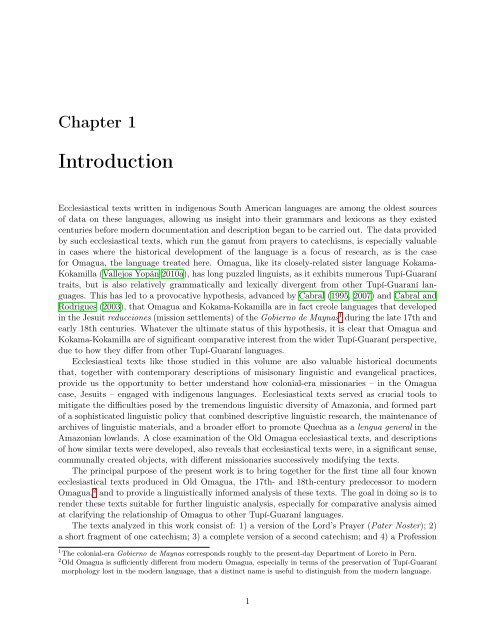draft manuscript - Linguistics - University of California, Berkeley
draft manuscript - Linguistics - University of California, Berkeley
draft manuscript - Linguistics - University of California, Berkeley
You also want an ePaper? Increase the reach of your titles
YUMPU automatically turns print PDFs into web optimized ePapers that Google loves.
Chapter 1<br />
Introduction<br />
Ecclesiastical texts written in indigenous South American languages are among the oldest sources<br />
<strong>of</strong> data on these languages, allowing us insight into their grammars and lexicons as they existed<br />
centuries before modern documentation and description began to be carried out. The data provided<br />
by such ecclesiastical texts, which run the gamut from prayers to catechisms, is especially valuable<br />
in cases where the historical development <strong>of</strong> the language is a focus <strong>of</strong> research, as is the case<br />
for Omagua, the language treated here. Omagua, like its closely-related sister language Kokama-<br />
Kokamilla (Vallejos Yopán 2010a), has long puzzled linguists, as it exhibits numerous Tupí-Guaraní<br />
traits, but is also relatively grammatically and lexically divergent from other Tupí-Guaraní languages.<br />
This has led to a provocative hypothesis, advanced by Cabral (1995, 2007) and Cabral and<br />
Rodrigues (2003), that Omagua and Kokama-Kokamilla are in fact creole languages that developed<br />
in the Jesuit reducciones (mission settlements) <strong>of</strong> the Gobierno de Maynas 1 during the late 17th and<br />
early 18th centuries. Whatever the ultimate status <strong>of</strong> this hypothesis, it is clear that Omagua and<br />
Kokama-Kokamilla are <strong>of</strong> significant comparative interest from the wider Tupí-Guaraní perspective,<br />
due to how they differ from other Tupí-Guaraní languages.<br />
Ecclesiastical texts like those studied in this volume are also valuable historical documents<br />
that, together with contemporary descriptions <strong>of</strong> misisonary linguistic and evangelical practices,<br />
provide us the opportunity to better understand how colonial-era missionaries – in the Omagua<br />
case, Jesuits – engaged with indigenous languages. Ecclesiastical texts served as crucial tools to<br />
mitigate the difficulties posed by the tremendous linguistic diversity <strong>of</strong> Amazonia, and formed part<br />
<strong>of</strong> a sophisticated linguistic policy that combined descriptive linguistic research, the maintenance <strong>of</strong><br />
archives <strong>of</strong> linguistic materials, and a broader effort to promote Quechua as a lengua general in the<br />
Amazonian lowlands. A close examination <strong>of</strong> the Old Omagua ecclesiastical texts, and descriptions<br />
<strong>of</strong> how similar texts were developed, also reveals that ecclesiastical texts were, in a significant sense,<br />
communally created objects, with different missionaries successively modifying the texts.<br />
The principal purpose <strong>of</strong> the present work is to bring together for the first time all four known<br />
ecclesiastical texts produced in Old Omagua, the 17th- and 18th-century predecessor to modern<br />
Omagua, 2 and to provide a linguistically informed analysis <strong>of</strong> these texts. The goal in doing so is to<br />
render these texts suitable for further linguistic analysis, especially for comparative analysis aimed<br />
at clarifying the relationship <strong>of</strong> Omagua to other Tupí-Guaraní languages.<br />
The texts analyzed in this work consist <strong>of</strong>: 1) a version <strong>of</strong> the Lord’s Prayer (Pater Noster); 2)<br />
a short fragment <strong>of</strong> one catechism; 3) a complete version <strong>of</strong> a second catechism; and 4) a Pr<strong>of</strong>ession<br />
1 The colonial-era Gobierno de Maynas corresponds roughly to the present-day Department <strong>of</strong> Loreto in Peru.<br />
2 Old Omagua is sufficiently different from modern Omagua, especially in terms <strong>of</strong> the preservation <strong>of</strong> Tupí-Guaraní<br />
morphology lost in the modern language, that a distinct name is useful to distinguish from the modern language.<br />
1
















